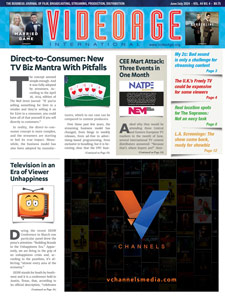The concept seemed simple enough. And it was fully adopted by streamers. According to the April 26, 2024 edition of The Wall Street Journal: “If you’re selling something for $100 to a retailer and they’re selling it on for $200 to a consumer, you could have all of that yourself if you sell directly to customers.”
In reality, the direct-to-consumer concept is more complex, and the streamers are starting to feel its true impact. Meanwhile, the business model has also been adopted by manufacturers, which in our case can be compared to content producers.
Over these past few years, the streaming business model has changed, from binge to weekly releases, from ad-free to advertising-based programming, from exclusive to bundling, but it is becoming clear that the DTC business model still needs to be redefined because it rests on four pillars that are not fully grounded: the finicky and unstable subscription model in the case of streaming (plus it’s still unclear whether a monthly or yearly subscription model should be used to reduce churn), the risky vertical integration used by DTC operators, the unequal supply and demand, and the reliance on data.
The elimination of binge-viewing for original content contributed to the so-called “viewer fatigue” resulting from the difficulties in finding new suitable shows. The data used for the streamers’ home screens to highlight a given user’s viewing patterns are not helping since viewers often fail to select their ideal shows because of the difficulties in finding them. Instead, they settle for the least objectionable new show, until, after one or two episodes, they simply turn the TV off because said show turns out to be unwatchable.
Economists tell us that, in actuality, the business basis is the same for every business: make a sale. But of course, the process of making a sale with the direct-to-consumer model differs from the process of making a sale using the wholesale model (which employs the so-called middleman concept, which was also adopted in broadcasting). And indeed, as the WSJ explained in the headline of the article quoted above: “Direct-to-Consumer Shift Brings Challenge.”
It used to be simpler for a producer to be in business: focus on the product and rely on a wholesaler to determine the quantity to produce, and produce only to fulfill sales orders. Today, producers have also become retailers since Wall Street pushed U.S. studios to follow the Netflix model, which had no legacy business to protect. In the process, the studios lost the discipline that characterized the traditional business model. With streaming the studios lost the cost factor — the cost of acquiring subscribers and the cost of producing original content.
In the past, new technologies did not cause the premature dismantling of legacy businesses: Home video did not crash broadcast TV, and cable TV did not destroy home video, which evolved into streaming services. What happened with DTC is unprecedented, forcing an untimely dismantling of the profitable linear model and pushing for a premature adoption of the on-demand model that only generated losses, more mergers, and more layoffs.
The evolution of the buying and selling business was a slow process that started as barter as early as 9000 BC. Sales in exchange for currency started back in 3000 BC, while the first retail store was found in ancient Greece in 800 BC. Wholesaling came into the picture during the Industrial Revolution in the 1800s, when mass production was developed. However, middlemen have existed since ancient times, but have gotten a bum rap for millennia even though they played a fundamental role in market operations in ancient Greece. According to Plato, middlemen were supposed to be unfit for any other job. To Aristotle, they were not even worthy of being full citizens.
The hostility towards middlemen eventually translated into legislation. Laws from various nations limited their profit margins, and price increases were attributed to the greediness of middlemen. Every time a famine struck there was even a temptation to blame them for it. Nonetheless, they survived.
The creation of the mail order business (a precursor of direct-to-consumer) was a consequence of the wholesale concept, and in the U.S. it was developed in Chicago by Aaron Montgomery Ward, who in 1872 was buying goods from various producers and then reselling them directly to customers and removing the middlemen in the form of the general store. But over the years, wholesalers and middlemen became synonymous.
Around the same period, in the 1880s, two business models emerged: the “vertical” integration” model used by Andrew Carnegie to integrate his supply chain for the steel industry, and “horizontal integration,” employed by John D. Rockefeller to control the oil industry. The former was subsequently adopted by the U.S. studios for theatrical movie releases, but relinquished in 1948 because of the anti-competition laws, and horizontal integration was never implemented in the entertainment sector because of anti-monopoly laws (the antitrust laws of the 1890s).
The media opened up to the wholesale business with advertising agencies (like Volney Palmer in Philadelphia in 1841), which brokered space for advertisers in newspapers. Palmer bought a large amount of space in various newspapers at a discount rate, and resold it at a markup. Over a century ago, ad agencies also started collecting 15 percent commissions for selling ads for publishers, and later for buying ad space for advertisers.
Over the years, advertising agencies reinvented themselves many times, including writing both commercials and the programming for their clients. This merger of programming and advertising continued into the early years of television until regulations changed and the practice died out. The model has reemerged recently in the form of product placement.
With the development of cable/satellite TV, U.S. studios found it more convenient, economical, and profitable to have intermediaries in the form of cable and satellite operators, which offered pay services to consumers either in a bundle or via a revenue-sharing model.
Today, real estate agents take five percent of sales prices, literary agents grab 15 percent of book deals, and talent agencies take 10 percent of performers’ fees.
However, the role of intermediaries between sellers and buyers is a role not much appreciated in American society, where dislike of all sorts of intermediaries (advertisers, lawyers, brokers, and agents) is frequently a part of the culture.
The studios’ idea to eliminate the middlemen — the TV stations’ network affiliates and the ad agencies — started in 1951 when Paramount began offering its Telemeter pay-TV service for a $5 installation fee (a service that they provided directly via broadcast) and a per-program fee to 3,000 TV households.
Other middlemen that the studios wanted to eliminate were the theater owners, who keep 50 percent of the box office receipts for themselves. The plot almost succeeded, until the studios realized that the theaters were the best way to promote their streaming features.
Indeed, the direct-to-consumer business is not something new. It has been circling businesses for many years, but it only took flight with the so-called “dotcom era,” starting in 1995, when the acronyms B2C and DTC became popular.
With the new millennium, the direct-to-consumer business model began to make believers out of folks in many different industries, especially in the retail sector.
With technological advantages, and at the encouragement of their retailers, more manufacturers (producers) started operating last-mile deliveries (i.e., closer to consumers’ homes), but instead of focusing on the product, they started focusing on the market.
In the DTC process, these producers discovered that they had to be vertically integrated in order to replicate the business of wholesalers. Plus, they had to master new business practices like fulfillment and home delivery. DTC effectively shifted storage and shipping costs from wholesalers to producers.
And if the rewards with DTC were potentially higher, so were the risks associated with increased competition, which resulted in higher advertising costs and marketing challenges. In addition, there were more production issues, like releasing new product more often, creating more inventory, developing packaging, and making return policies. For those reasons, last year, Nike, for example, returned to selling to retailers in order to clear out merchandise (overstuffed inventory).
In the case of Hollywood’s streamers, in 2022 the studios were convinced that with broadband readily available, they could have gone directly to the consumers, thereby eliminating the aggregators (middlemen in the form of cable TV operators), and doing away with the advertising agencies (by simply charging a subscription fee).
A year later, in 2023, the studios’ streamers were losing an estimated $10 million a month each and quickly called back the advertising agencies to bring in clients willing to buy commercial spots. The cable TV middlemen also came back with demands that they carry the studios’ ad-supported streaming services (if they wanted to receive payments for the studios’ TV networks and their own local TV stations’ retrans fee, and also keep the studios’ cable channel carriage fees). Bundling, in which multiple services are packaged and sold as one by middlemen, is also making a comeback.
DTC created additional disciplines in the form of a subscription economy and big data analysts. This subscription economy is now pervasive, spanning from streaming services and cable TV, to magazines and daily newspapers, alarm services, wine deliveries, gym memberships, digital newsletters, and even car wash services.
The New York City-based consulting firm West Monroe reported that in a survey about monthly subscription expenditures, people guessed that they spent $62 on various subscriptions, when in reality they spent a whopping $273.
It is also clear that the cultural environment between the two business operations — the traditional wholesale model and the DTC model — needs to better integrate. As demonstrated by the success of Netflix and some other manufacturers, those who started in the DTC business have had better results than producers who adapted to the DTC business after being previously grounded in the retail or wholesaler model.
(By Dom Serafini)
Audio Version (a DV Works service)










Leave A Comment